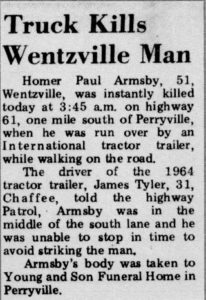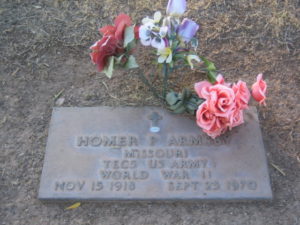My posting about the sad fate of my beloved Uncle Paul, who vanished without trace from my life when I was a boy, brought me a fair amount of correspondence, including a note from a reader who was kind enough to e-mail me an electronic copy of something that I’d been unable to find on the web: the original newspaper story about Paul’s death.
 Having written four biographies and a memoir, I’ve learned from hard experience how imperfect memories—my own included—can be. No matter how clear those memories may seem to be, primary sources have a way of sneaking up from behind and taking you by surprise. The story about Paul’s death that appeared in my hometown paper contained quite a few such surprises, starting with the fact that his full name was Homer Paul Armsby. To me, of course, he was “Uncle Paul” pure and simple, and I can’t recall anyone in my family ever calling him “Homer.”
Having written four biographies and a memoir, I’ve learned from hard experience how imperfect memories—my own included—can be. No matter how clear those memories may seem to be, primary sources have a way of sneaking up from behind and taking you by surprise. The story about Paul’s death that appeared in my hometown paper contained quite a few such surprises, starting with the fact that his full name was Homer Paul Armsby. To me, of course, he was “Uncle Paul” pure and simple, and I can’t recall anyone in my family ever calling him “Homer.”
Even more surprising to me was that Paul died in September of 1970, when I was fourteen years old. I last remember seeing him in 1966, and my brother, who is four years younger than me, barely remembers Paul at all. My best guess is that he paid his final visit to our house in Smalltown in 1967, though that’s only a guess. I’d wrongly supposed that he died shortly thereafter, but it appears instead that he moved to Wentzville, a town not far from St. Louis, and lived there on his own for a few years after his marriage to Aunt Suzy came to an end.
In all other particulars, my memory of Paul’s death is borne out by the bare facts that are recorded in the story: he was run over by a truck while walking in the middle of Highway 61 at a quarter to four in the morning. The rest is easy enough—too easy—to imagine.
My reader also sent me something even more surprising, a longer obituary published in an Arizona newspaper:
Mr. Armsby, a heavy equipment operator who formerly lived in Arizona three years, was killed in a vehicle accident Friday at Perryville, Mo. He was an Army veteran of World War II and a 32nd degree Mason in St. Louis. He was born in Corning, Ark.
It was news to me that Paul had lived in Arizona, much less that he had roots there. According to the obituary, he was survived by his parents, a brother, and three sisters, all of whom were living in the Phoenix area in 1970, as well as four other brothers and sisters who lived in Missouri. I wouldn’t be greatly surprised if one or two of his siblings are still alive, though I don’t intend to investigate further. Given the circumstances of his death, I can’t imagine that their memories of their brother are anything other than painful.
 I’m glad, though, to know where Paul was laid to rest, for I had feared that he might possibly lie in an unmarked pauper’s grave. Not so: his body was returned to Arizona for burial in the Mountain View Cemetery of Mesa, an elaborately appointed institution reminiscent of Forest Lawn whose paths are lined with tall palm trees. My brother even managed to track down a photograph of the simple plaque that marks his grave, on which he is identified as “Homer P. Armsby,” a World War II vet. Since four other members of the Armsby family are buried in the same cemetery, it seems probable that there is no one left in Mesa to mourn him.
I’m glad, though, to know where Paul was laid to rest, for I had feared that he might possibly lie in an unmarked pauper’s grave. Not so: his body was returned to Arizona for burial in the Mountain View Cemetery of Mesa, an elaborately appointed institution reminiscent of Forest Lawn whose paths are lined with tall palm trees. My brother even managed to track down a photograph of the simple plaque that marks his grave, on which he is identified as “Homer P. Armsby,” a World War II vet. Since four other members of the Armsby family are buried in the same cemetery, it seems probable that there is no one left in Mesa to mourn him.
Shakespeare said it: What can we bequeath/Save our deposed bodies to the ground? But of course that isn’t quite true: most of us also leave behind memories, some good and others nightmarishly bad. A half-century after he was run over on Highway 61, I still remember Paul, and because he took great care never to let me see him in any other light, I think of him not as the unhappy man that he eventually became but as the sweet, kindly uncle who sang “You Are My Sunshine” to me when I was a little boy. I’m glad for that.
* * *
Jimmie Davis sings “You Are My Sunshine” in 1939:
Frank Sinatra sings “One for My Baby” at London’s Royal Festival Hall in 1962, accompanied by Bill Miller:
